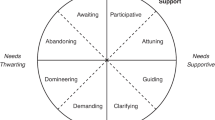Abstract
Ten autistic children were exposed to four different styles of approach by an adult, in which the common context was the child's involvement in the completion of a model-building task. These styles varied in the extent to which they made interpersonal demands of the child and in the amount of task-directed structure that was imposed. Measures based upon observation of the adult's and the children's behavior indicated that the styles applied were reliably discriminable, and that the children's responses, both social and task-directed, were positively related to the interpersonal and task-oriented demands that were made of them. Within the group of children tested, some individual differences in the responses to the styles were suggested that may be relevant to the diagnosis of autism.
Similar content being viewed by others
References
Axline, V. M.Play therapy. Boston: Houghton Mifflin, 1947.
Bartak, L. Educational approaches. In M. Rutter & E. Schopler (Eds.),Autism: A reappraisal of concepts and treatment. New York: Plenum, 1978.
Bartak, L., & Rutter, M. Special educational treatment of autistic chldren: A comparative study: I. Design of study and characterisation of units.Journal of Child Psychology and Psychiatry, 1973,14, 161–179.
Berkson, G., & Mason, W. Stereotyped behaviour of chimpanzees: Relation to general arousal and alternative activities.Perceptual and Motor Skills, 1964,19, 635–652.
Clark, P., & Rutter, M. Compliance and resistance in autistic children.Journal of Autism and Childhood Schizophrenia, 1977,7, 33–48.
Clark, P., & Rutter, M. Task difficulty and task performance in autistic children.Journal of Child Psychology and Psychiatry, 1979,20, 271–285.
Currie, K. H., & Brannigan, C. R. Behavioral analysis and modification with an autistic child. In S. J. Hutt & C. Hutt (Eds.),Behavior studies in psychiatry. Oxford: Pergamon, 1970.
Ekstein, R. The space-child's time machine: On “reconstruction” in the psychotherapeutic treatment of a schizophrenoid child.American Journal of Orthopsychiatry, 1954,24, 492–506.
Hutt, S. J., & Hutt, C. Stereotypy, arousal and autism.Human Development, 1968,11, 277–286.
Lovaas, O. I., Schaeffer, B., & Simmons, J. Q. Experimental studies in childhood schizophrenia: Building social behaviour in autistic children by the use of electric shock.Journal of Experimental Research In personality, 1965,1, 99–109.
Richer, J. The social avoidance behavior of autistic children.Animal Behavior, 1976,24, 898–906.
Richer, J. The partial communication of culture to autistic children: An application of human ethology. In M. Rutter & E. Schopler, (Eds.),Autism: A reappraisal of concepts and treatment. New York: Plenum, 1978.
Richer, J., & Coss, R. G. Gaze aversion in autistic and normal children.Acta Psychiatrica Scandinavica, 1976,53, 193–210.
Rutter, M. Diagnosis and definition. In M. Rutter & E. Schopler (Eds.),Autism: A reappraisal of concepts and treatment. New York: Plenum, 1978.
Rutter, M., & Bartak, L. Special educational treatment of autistic children: A comparative study. II. Follow-up findings and implication for service.Journal of Child Psychology and Psychiatry, 1973,14, 241–270.
Rutter, M., Graham, P., & Yule, W.A neuropsychiatric study in childhood. London: Spastics International Medical Publications, 1970.
Schopler, E., Brehm, S., Kinsbourne, M., & Reichler, R. J. The effect of treatment structure on development in autistic children.Archives of General Psychiatry, 1971, 415–421.
Schopler, E., & Rutter, M. Subgroups vary with selection purpose. In M. Rutter & E. Schopler (Eds.),Autism: A reappraisal of concepts and treatment. New York: Plenum, 1978.
Stutsman, R.Guide for administering the Merrill-Palmer Scale of Mental Tests. New York: Harcourt, Brace and World, 1948.
Tinbergen, E. A., & Tinbergen, N. Early childhood autism: An ethological approach.Advances in Ethology, 1972,10.
Tinbergen, N. Ethology and stress diseases.Science, 1974,185, 20–27.
Wechsler, D.Wechsler Intelligence Scale for Children. New York: Psychological Corporation, 1949.
Winer, B. J.Statistical principles in experimental design. New York: McGraw-Hill, 1962.
Author information
Authors and Affiliations
Additional information
Financial support for this research was provided by the Bethlem Royal and Maudsley Hospitals Research Fund. The authors appreciate the cooperation of the staff of the Sybil Elgar School and Heathlands School during the execution of this study. Thanks are also due to Eileen Schwartz, Hilary Piercy, and Sheila Rutter for patiently and carefully coding the video recordings.
Rights and permissions
About this article
Cite this article
Clark, P., Rutter, M. Autistic children's responses to structure and to interpersonal demands. J Autism Dev Disord 11, 201–217 (1981). https://doi.org/10.1007/BF01531685
Issue Date:
DOI: https://doi.org/10.1007/BF01531685




